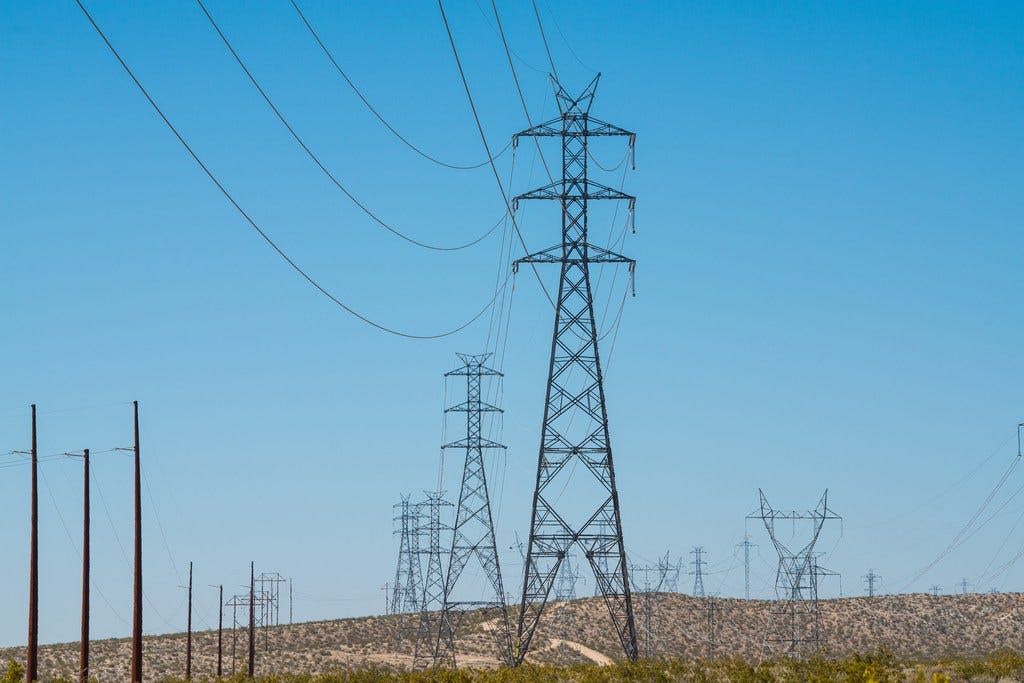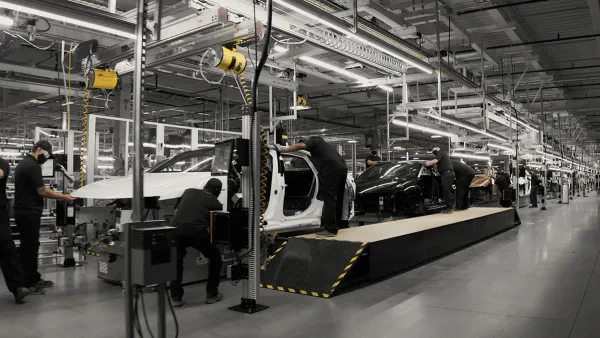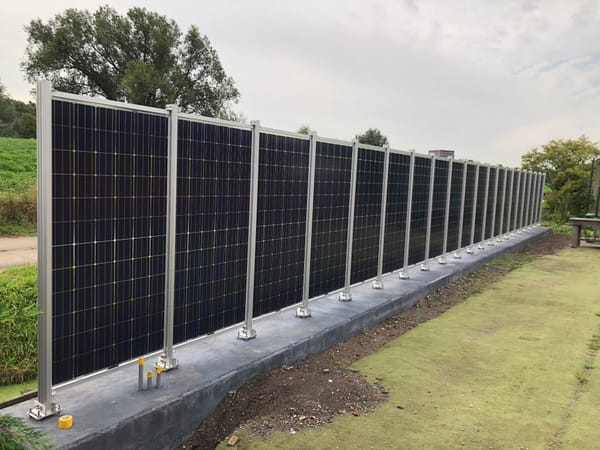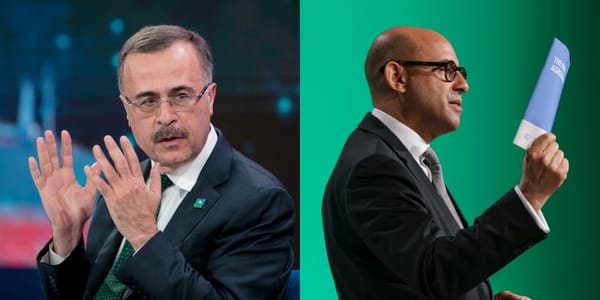What’s the big deal about electricity transmission? It’s about going green.
Good afternoon!
Missed you yesterday! I had a big project with a deadline, so the newsletter kinda got pushed back. But I’ll make it up to you with one today, and one tomorrow. Today, I’m writing about electricity transmission, and how it is the crux of the green energy revolution.
-Mike

Transmission lines in Barren Ridge, Calf. built specifically for wind power for Los Angeles. (NREL)Let’s imagine you’re in Northern Illinois right now. Yesterday you dealt with a 125-degree Fahrenheit heat index, which is downright deadly. Just hot enough that it’s difficult for your body to cool off if you don’t have access to water or air conditioning. Today it’s going to be more of the same.
However, if you live in a home with air conditioning, which over 80% of Americans do, then worries drain away with the flip of a switch. Electricity flows from the wires on your street or alley, powering your air conditioner (or maybe heat pump), cooling your home to a comfortable 75-degrees, or maybe cooler if you’re feeling decadent.
It’s a modern marvel of engineering, and infrastructure, that connects your house to the local distribution grid, then across tall towers carrying transmission lines, to a power plant where your electricity is generated. A simple, but staggeringly large system that makes sure you and millions of others stay cool and connected to the internet so you can read this blog post.
Except it isn’t actually that simple.
In recent decades the way we generate electricity has changed dramatically, which has forced big adjustments of how we move it around as well as how we deliver it to consumers on those “electric side streets”. The speed at which we adapt our electricity delivery – commonly referred to as “the grid” – will have a big impact on how green we can make our economy, and whether or not we’ll be able to supply power for all those electric cars, induction stoves, and new electric HVAC systems as American cities use less heating oil and natural gas.
What’s changed?
Closest to home, many Americans are generating their own electricity with solar panels and batteries that allow them to avoid pulling power from the grid during the day, sometimes sending power back to the grid if they have more than they can use. This means utilities have to allow “net metering” that monitors not just electricity flow to your house, but also back to the grid. This sounds like no big deal, until you consider that tens of thousands of consumers might want to do this, at rates that are largely reflective of weather patterns, a new, often unpredictable wrinkle a grid manager has to watch.
Electric cars are also a huge change that has no clear pathway. Will we have to build hundreds of chargers in existing, barely wired parking garages? Will street parking need chargers? Every night, homes will likely be drawing much more power to charge EVs, a time when traditionally homes used less power. Will there be roadside charging stations next to busy interstates for dozens of cars pulling power? How should utilities predict what new infrastructure to build?
On the other end of the system, generation has changed a great deal too. While thirty years ago most power came from giant nuclear or fossil fuel plants that generated thousands of megawatts in locations relatively close to population centers, now power generation is distributed across a wide area, sometimes hundreds of miles away, that comes from smaller solar and wind farms that generate hundreds of megawatts, but from many locations. Also, many of the new power sources are not owned by the local utilities who deliver power to consumers, but are instead owned by independent companies
No big deal, right? Just plug ‘em in and start making power!
Well, that’s where it gets tricky: moving the power to local distribution grids, or transmission.
It turns out that since the start, transmission has been the worst managed part of the American electricity system. It’s nobody’s fault, largely because for the longest time, transmission wasn’t something anyone had to worry much about. If you were a utility, you made sure your coverage area had enough power, so you built more power plants. And when the power plants got too big to be located in a city, you strung up some big wires to move the electricity to the cities.
Gradually, utilities started buying power from places far away that were not part of their company, like the Hoover Dam, so they strung up new wires to buy power from someone else. Then, about forty years ago, utilities started trading power between each other, to cover their gaps. If Utility A is running a little low at 5:00 p.m. every day, and Utility B has extra every day around then, then A strings up wires from B, and an “interconnection” is born.
More and more of this power sharing went on, so utilities created regional grids with other utilities to make sure everyone in the area had enough power. But the grids were geographically limited, like PJM, which serves Pennsylvania, Ohio, Virginia, Kentucky, New Jersey, and Maryland (and oddly, Chicago). Or the Southwest Power Pool, which spans the plains states from Eastern Montana to Oklahoma and Northern Texas.

Despite the size of the regional grids, they still had localized weather patterns to deal with. So when it’s hot, it’s likely hot for the whole area, increasing the grid’s demand. If regional solar and wind plants are enjoying good days, where can they send that extra power? Or if they need more power, where can they pull it from?
In the past, the solution was to build expensive “peaker” fossil fuel power plants that just stayed dormant until peak demand arose. You fired it up for a few hours, then shut it down when demand dissipated.
But the rise of distributed, green power means you can just pull power from another region that has extra windy or sunny weather – excess capacity – if you have the transmission lines to do it.
And here is the big problem: The American transmission grid was not purpose built, it just kinda happened. And nobody’s really responsible for it. Sure, there are organizations (see above) that run it, but those are essentially run by committees of utilities who are incented to build capacity just for their own purposes, not for anyone that might want to transit their territory to another area, because owning and operating transmission is a headache, and doesn’t make nearly as much money as selling power to local customers.
Along the way, there’s local governments that don’t really like having unsightly transmission lines in their area as well as environmentalists who don’t like them, so there’s lots of local permit battles. Many states have also given local utilities first right of refusal to build transmission lines, which allows them to block lines essential to the survival of green power projects not owned by the utility.
When areas hit temperature extremes, regional grids are strained, as Midwest utilities have been warning customers this week. More and longer transmission lines to green power sources across the country would improve matters greatly.
WIth opposition from local power companies, local governments, and the slow grind of permitting, the average transmission project is tied up in red tape for five years
Although there is a central federal authority for power lines, the Federal Electricity Regulatory Commission (FERC), that agency only has a veto authority over new lines and tearing down existing ones, not an ability to spur building new lines. But even then, states and local governments have their own veto authority the federal government can’t overrule.
What’s missing is something like the Federal Highway Authority, which draws up desired interstate pathways, then channels federal money to states so they can build the roads and sets standards for existing roads so they all operate the same way. But that’s nowhere in federal plans today, because it would be considered overreach.
Where are things today? Not getting much better. Federal legislation to allow the federal government to override local permitting fights was quashed last fall in a Senate fight with Sen. Joe Manchin, and seems dead for now. The Biden Administration is working around the margins of the problem with new administrative rules, but without an act of Congress, not much will change.
Other Things Happened
- Heatmap has a good rundown on what the various GOP presidential candidates think about climate change.
- Scientists say the likelihood of Canada’s extensive wildfires doubled because of climate change.
- Ecuardorians just voted to ban mining in a hyper-biodiverse area and to halt oil drilling in the Amazon.
- Climate change denial is a form of mental self-preservation, say researchers.
Welcome to the end of the newsletter! Here’s the Top Italian Beefs in Chicagoland.





